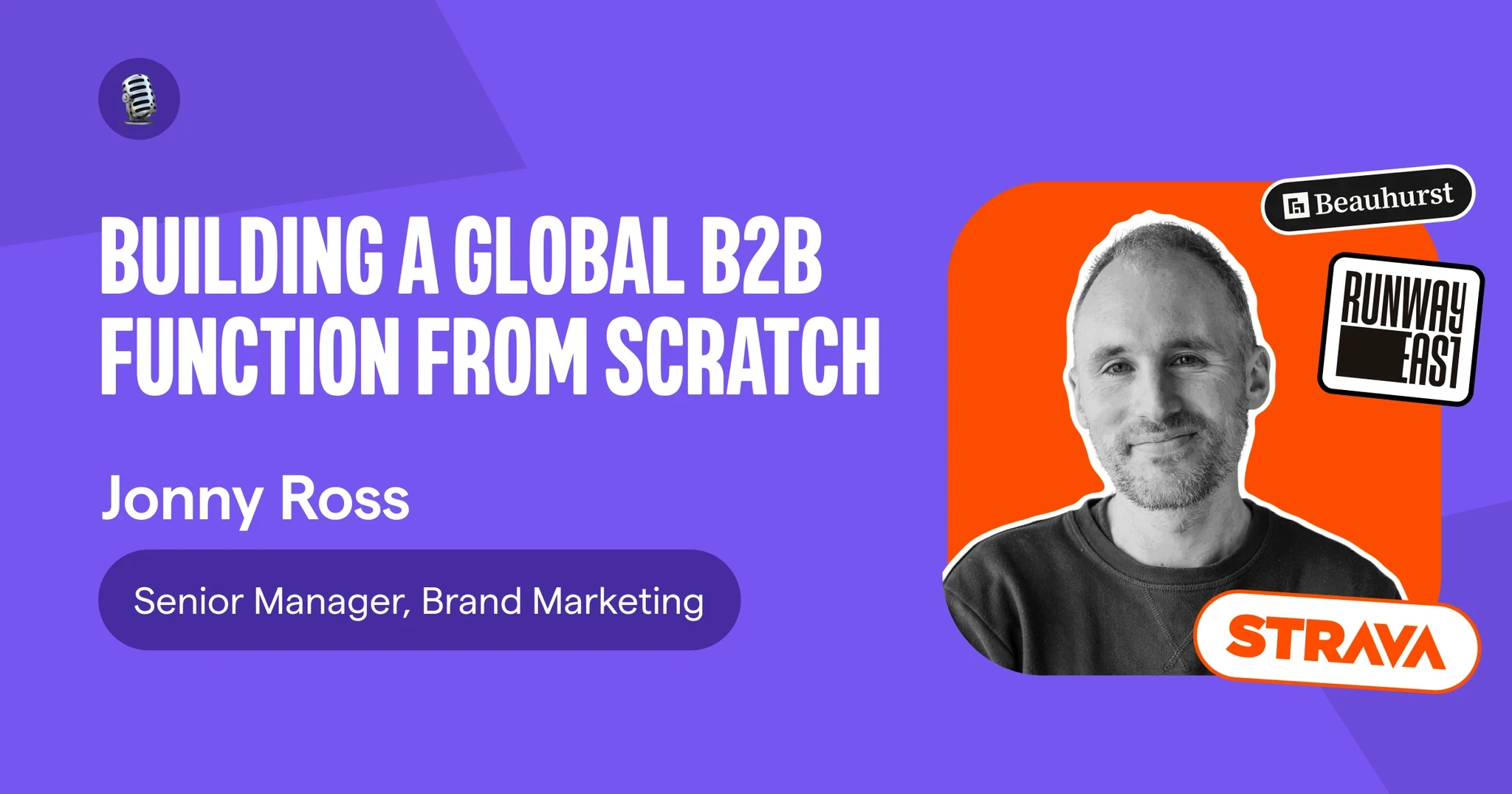Wednesday, 24 January 2024
·

Ben Hacking
Co-founder & CEO
tl;dr
Tracking the route to senior management ✨
Ben Hacking: You're a 15 year growth marketer and currently the Senior Manager of Brand Partner Marketing at Strava. How did you get there?
Jonny Ross: I landed in B2B by accident. I studied music at the University of Nottingham, and worked for an artist management agency to stay in the arts. After a while I realised how small the arts industry is and started looking at marketing roles outside of it. I spent the next few years in various marketing roles, running marketing for Portland, a communications agency, then Head of Marketing at Beauhurst, where I really started cutting my teeth in B2B.
Ben Hacking: How did you then leap into Strava?
Jonny Ross: Pre-pandemic, most companies weren’t experimenting with remote work, and I moved to Bristol which meant leaving my London role at Beauhurst. I then joined Gradwell, followed by Runway East, as their Head of Marketing. One day, I came across this B2B role at Strava, which sounded very interesting.
Ben Hacking: Let me interrupt, I thought Strava was a B2C social fitness network and tracking app?
Jonny Ross: That’s what made this role so exciting to me. They were looking for someone to come in and build the foundation of a B2B growth marketing function for their emerging B2B sales team.
The path from prospect to partner 🤝
Ben Hacking: How did you approach building the B2B growth marketing function from scratch?
Jonny Ross: Step 1 was building a hand-picked list of target brands and making sure that we’re at least in consideration for their media buying. We built an SDR/BDR function and began the process of raising awareness of our B2B offering.
Ben Hacking: What is Strava’s B2B product offering?
Jonny Ross: Our main products are a type of activation called a Sponsored Challenge. A brand targets a set of users to complete a challenge, and rewards them with an incentive, claimed on their website. We’re also adding other products, like co-created content on Strava Stories, so watch this space!
Ben Hacking: Who are these target brands that your B2B team is selling to?
Jonny Ross: Primarily, brands that naturally speak to an audience with an active lifestyle.
Ben Hacking: Once you identify your target brands, how do you market to them?
Jonny Ross: We’re a small team, so we focus on the basics: educating our target market through content, reaching out to them in a personalised way, and promoting our messages and content where we know they hang out.
Ben Hacking: What else does your B2B growth marketing playbook have?
Jonny Ross: Truthfully, we stick to the obvious items. Beyond outreach and referral, we’ve tested LinkedIn Ads to get in front of the decision makers at our target brands
Ben Hacking: Are you hesitant to experiment with other growth channels?
Jonny Ross: No, not hesitant. As a small team with limited test budget, we need to move with conviction. But more, we want to know what works. When we experiment with a new channel, we want to make sure we have precise reporting and can measure its impact, or lack thereof. For us, it’s about incremental iterations in the right direction.
The Role of AI in Account Based Marketing 🤖
Ben Hacking: What tools and platforms is your B2B team getting value from at the moment?
Jonny Ross: We use tools like HubSpot, Zoom and Figma, occasionally Canva, too – combined with good old Google Sheets. At the moment, Hubspot is what we really get a lot of value from.
Ben Hacking: Hubspot and Canva are both introducing AI tools. Have you had the chance to use these?
Jonny Ross: I’ve played with ChatSpot, but not Magic Design. I'm sure you've seen HubSpot's AI Roadmap, where they share they’re testing ability to ask questions of your data and dynamically build reports.
Ben Hacking: Would that be useful?
Jonny Ross: If Hubspot could crack AI, it would be an absolutely amazing product. We’d really benefit from being able to structure our data and identify where our data is incorrect or wrong, report on that data, and perform predictive analysis.
Ben Hacking: What other AI tools have you found useful?
Jonny Ross: In my personal time, I’ve played around with chatGPT and Bard. Because Bard is linked up with search I've used it for live information. Whereas chatGPT is almost more of an idea generation rather than a research tool that’s been great for brainstorming blog titles, or distribution plans, but so much starts with the prompt.
Ben Hacking: When it comes to AI and marketing, is there anything on your growth marketer wishlist?
Jonny Ross: I’d be interested in the AI tools that focus on channel performance. I’d also consider multi-touch attribution. If I were able to look at a contact's journey over time, touchpoints, and deal notes, then ask it questions, that would be powerful in instructing our next action. Then data, there is a lot of hidden data in marketing, which is a huge headache. Primarily though, I’d want AI to fix the biggest problem in B2B, which is bad or inconsistent CRM data.
Building ABM at Billion Dollar companies 🎯
Ben Hacking: For someone building out a B2B account based marketing function, what’s step 1?
Jonny Ross: The most important thing that you can do when building ABM is get a good list. The next most important item is knowing your value proposition for the names on that list and why they want what you’re reaching out to them about.
Ben Hacking: How do you go about building that list?
Jonny Ross: An effective way to build a pipeline includes identifying ICPs to focus efforts then taking those parameters and building lists from search, LinkedIn, or other prospecting platforms. More advanced teams can use intent data tools, events, content syndication, and social selling. Then the key is about introducing your offering to them in a way that brings them value.
Ben Hacking: How might marketers know if they’re getting the right message to the right people?
Jonny Ross: Reps and self evaluation. I was on Dave Gerhardt’s podcast recently and we agreed that, at the end of the day when you take all the tech and all the cool platforms out of it, as a brand, are you credible? Are you saying interesting things that are valuable to your target audience? If you imagine a Venn diagram, a brand has an interesting product on one side, and on the other is what people are interested in. The marketer’s aim is land in the middle where those two items intersect. Then doing that over and over again.
Ben Hacking: Are there any other success stories or tips that you can share?
Jonny Ross: In a previous role, I took over a monthly newsletter, and noticed we were only sending to a segment of the audience. In our next send, we included anyone who had shown a legitimate interest in our product before. Then, we updated our frequency, and changed the sender name to come from a real person that recipients could respond to. This created a thought leader for our readers. They loved subscribing to it and it became a serious growth driver for us.
Breaking into B2B 🧑🎓
Ben Hacking: What tips would you give to your younger self, or someone wanting to break into B2B marketing?
Jonny Ross: The cliche but the obvious advice is to just read up as much as you can. There's so many amazing free resources online, particularly YouTube, and various blogs and newsletters to learn from. Then follow influential people, and use your own logic to discern what is and isn’t good advice.
Ben Hacking: For a health and wellness, movement, or athletic adjacent brand, or aspiring B2B marketing looking to get in touch, how might they?
Jonny Ross: I’ll invite any interested brand to tell us a bit more about their organisation here, and all others to reach out on LinkedIn.


